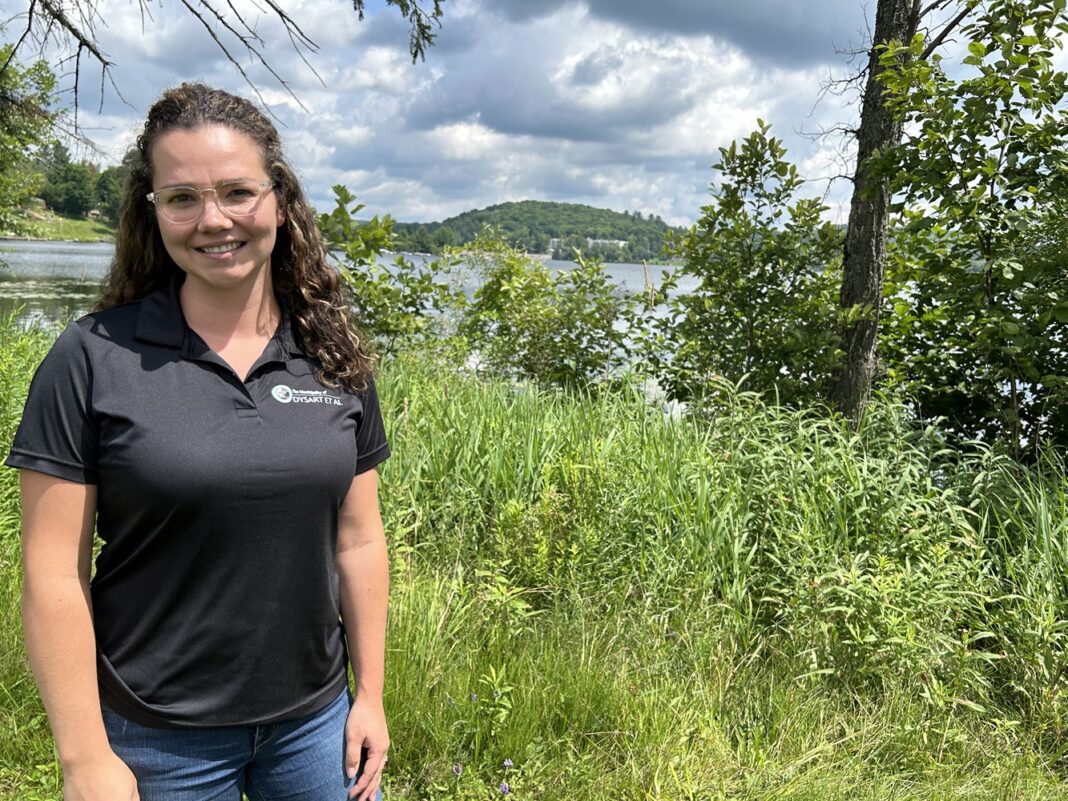Editor’s note: this story has been altered to reflect necessary corrections in number of staff the County of Haliburton hired to manage its shoreline preservation bylaw, and also includes updated statistics.
Warden Liz Danielsen has given the County’s shoreline preservation bylaw a passing grade more than one year from its implementation, while Dysart et al mayor Murray Fearrey believes his township’s new site alteration bylaw is also making a difference.
The new shoreline preservation bylaw was endorsed by Algonquin Highlands, Minden Hills, and Highlands East, coming into effect April 1, 2023.
The main purpose, Danielsen said, was to strengthen existing controls for waterfront development. The bylaw regulates the removal of trees and alteration of land grades within 20 metres of the County’s lakes, rivers, and wetlands.
The County hired one new staff member to run the program. A new permitting system has also been established, forcing applicants to ensure shoreline development plans comply with the bylaw before work can proceed.
Elizabeth Purcell, the County’s new director of planning, said staff have followed up on 82 complaints from the public to date, issuing stop work orders at 11 sites and “some form of remedial action” at 22 properties. Of those complaints, 39 came from one individual – with 27 “not found valid based on the parameters of the bylaw.”
Danielsen said, “rollout seems to have gone well, particularly with an emphasis on education and efforts to bring folks into compliance rather than immediately taking enforcement action… the number of files and ongoing action tied to them seems reasonable.”
She noted many complaints were related to work completed prior to the bylaw coming into effect. “In these cases, we are unable to take any enforcement action.”
Purcell estimated the first-year costs at approximately $118,000, including $5,000 for legal fees. She said they are split between the three townships.
While the County has collected around $4,000 in permit revenues, Purcell said the program is about more than money.
“This bylaw program stems from council’s decision to ensure the long-term health of our lakes, which remains the priority over cost,” she said.
Dysart different
Dysart et al was the sole County township not to endorse the bylaw. Instead, its council rolled out its own legislation focusing on site alteration. Approved and adopted last August, Dysart’s bylaw has a similar mandate – enhancing the protection and encouraging the preservation of natural shorelines.
Karl Korpela, Dysart’s chief building official, said it regulates all site alteration within 30 metres of a lake or in environmentally-protected areas. The program is managed in-house by existing staff.
The bylaw is solely complaint-based, with no pre-screening of development plans. Korpela said the municipality has followed up on four cases of potential illegal site alteration. Two investigations were completed without any fine being levied, while the other two are still in process.
Korpela said the bylaw has been wellreceived, particularly by the building industry.
“The main focus is on education – discussing silt control and erosion protection requirements with building and septic contractors on-site during regular building inspections,” Korpela said.
The building officer is excited about a new shoreline lake health assessment staff are completing while conducting septic inspections. It provides owners with a score based on existing native vegetation along the shore.
Bri Quinn, who manages the assessments, said 61 were completed in May on properties overlooking Benoir, Elephant, Farquhar, Fishtail, and Grace lakes. Of those, 25 scored between 90 and 100 per cent; 12 between 80 and 89 per cent; 10 between 70 and 79 per cent; and nine between 60 and 69 per cent. Five properties scored between zero and 49 per cent.
“The results have been pretty exceptional – there haven’t been too many low scores. Homeowners, for the most part, are asking a lot of questions… it’s provided some fun competition for people,” Quinn said.
Following the assessment, property owners are given a digital report showing the rationale for their score, and how they can improve it. Quinn reiterated the process is strictly educational – no remedial actions have been levied.
Fearrey believes his council got it right opting for site altercation over shoreline preservation.
“There are opportunities to connect with people before they have work done. We’re addressing things before they happen. We’re talking to people about the reasons why they can’t do things – that’s a big plus for me.
“To only have four complaints in a year in a municipality our size is huge. The aim isn’t to make a ton of money through fines, it’s to protect our lakes and shorelines. I think we’re doing a pretty good job of that without having to spend the world. We’ve probably saved $100,000 doing things the way we are,” Fearrey added.
Korpela said the spend on site alteration bylaw-related expenses has been negligible – around $900 for educational materials.
Despite the difference in cost, Danielsen still feels it’s unfortunate Dysart did not subscribe to the County bylaw.
“It is always easier for residents of Haliburton County to have the same rules applied throughout the County, reducing confusion and possible frustration,” Danielsen said.
Bylaws necessary
Michael Thomas, president of the Paudash Lake Conservation Association, said legislation protecting shorelines is more important than ever. With more people frequenting the Highlands and lakes busier, there’s an increased risk to watershed health, he said.
“These programs are vital if we want to maintain our pristine lakes, which is what we’re really known for,” Thomas said.
There is evidence suggesting some local lakes are deteriorating – there were unconfirmed reports of blue green algae blooms on at least two County lakes last summer, while Thomas confirmed Paudash saw its first ever bloom in early July.
“It’s not good, but we’re using it as an educational tool to show people what can happen if you’re not responsible. These types of blooms occur, often, because of run-off from someone’s property getting into the water. That’s why the shoreline bylaw is so important,” Thomas said.
Andy Gordon, director at U-Links and a former professor of forest ecology at the University of Guelph, feels both programs have their merits but could be bolstered by introducing key performance indicators on the aquatic side.
“We know how they’re working politically, the acceptance levels, the costs… what is lacking is something that would indicate we’re seeing improvement in near-shore lake health, that’s something U-Links could assist with,” Gordon said.
He added U-Links, with the support of the County and other partners, has continued to expand its water quality testing program in the Highlands, and is currently engaging with more than 25 lake associations.
Gordon said he’s pleased with that commitment to engage the local community. Gordon feels the bylaws have the potential to make a real difference.
“The bylaws are very important to make sure we do maintain pristine water quality, because that is directly tied to the economy of Haliburton County. Pristine lakes equal tourists, which equal money, which equals jobs for more people up here.”





